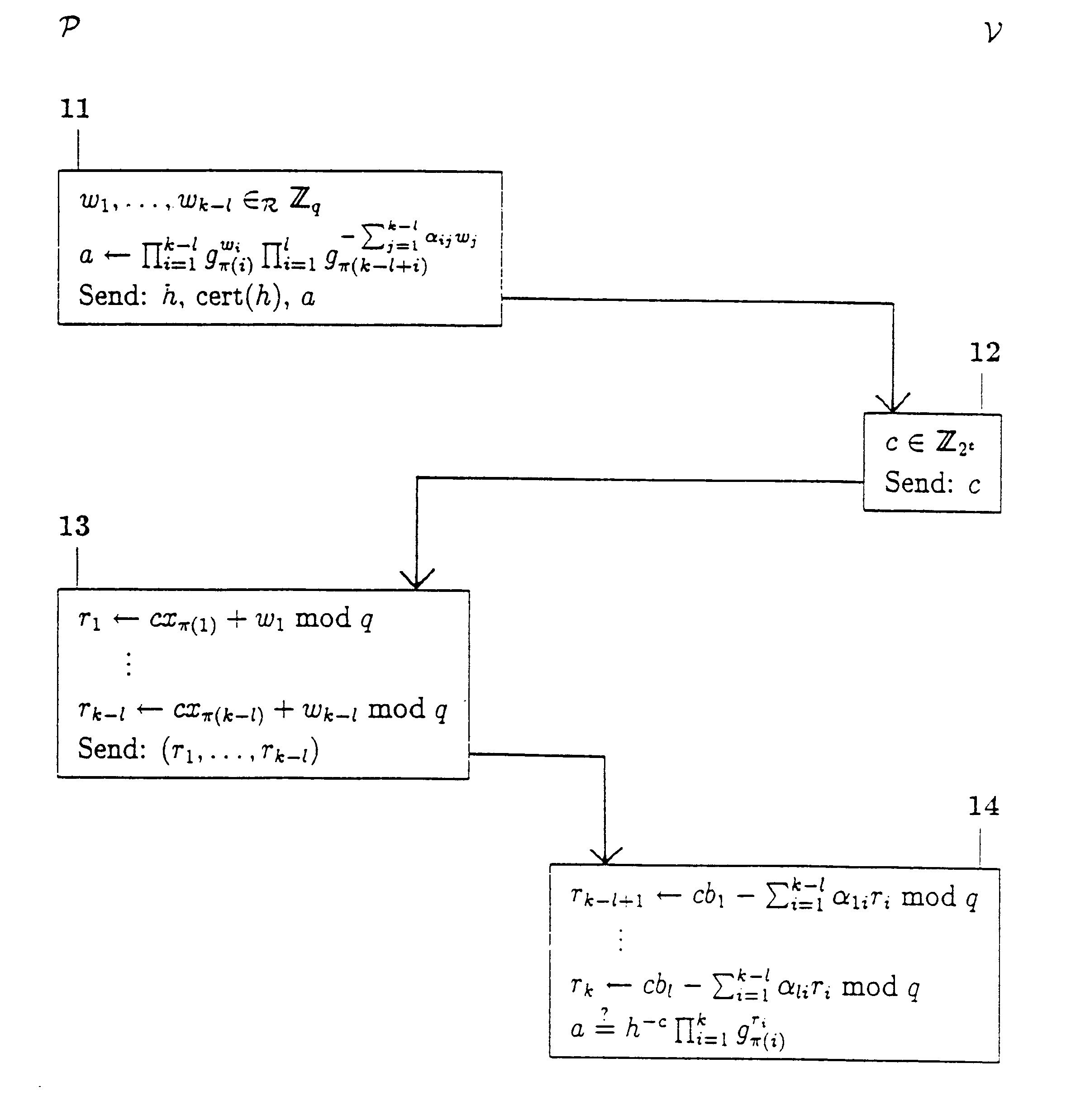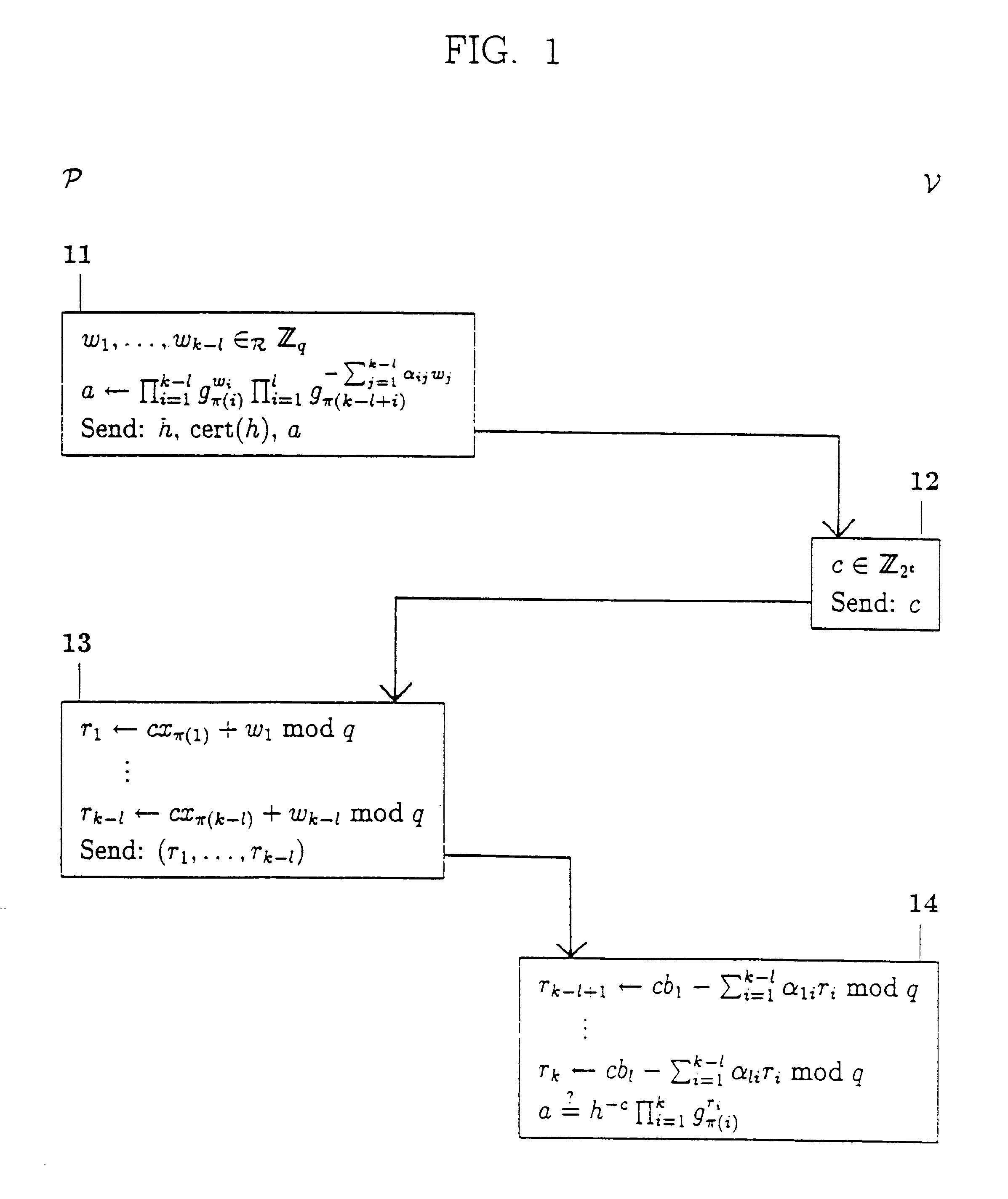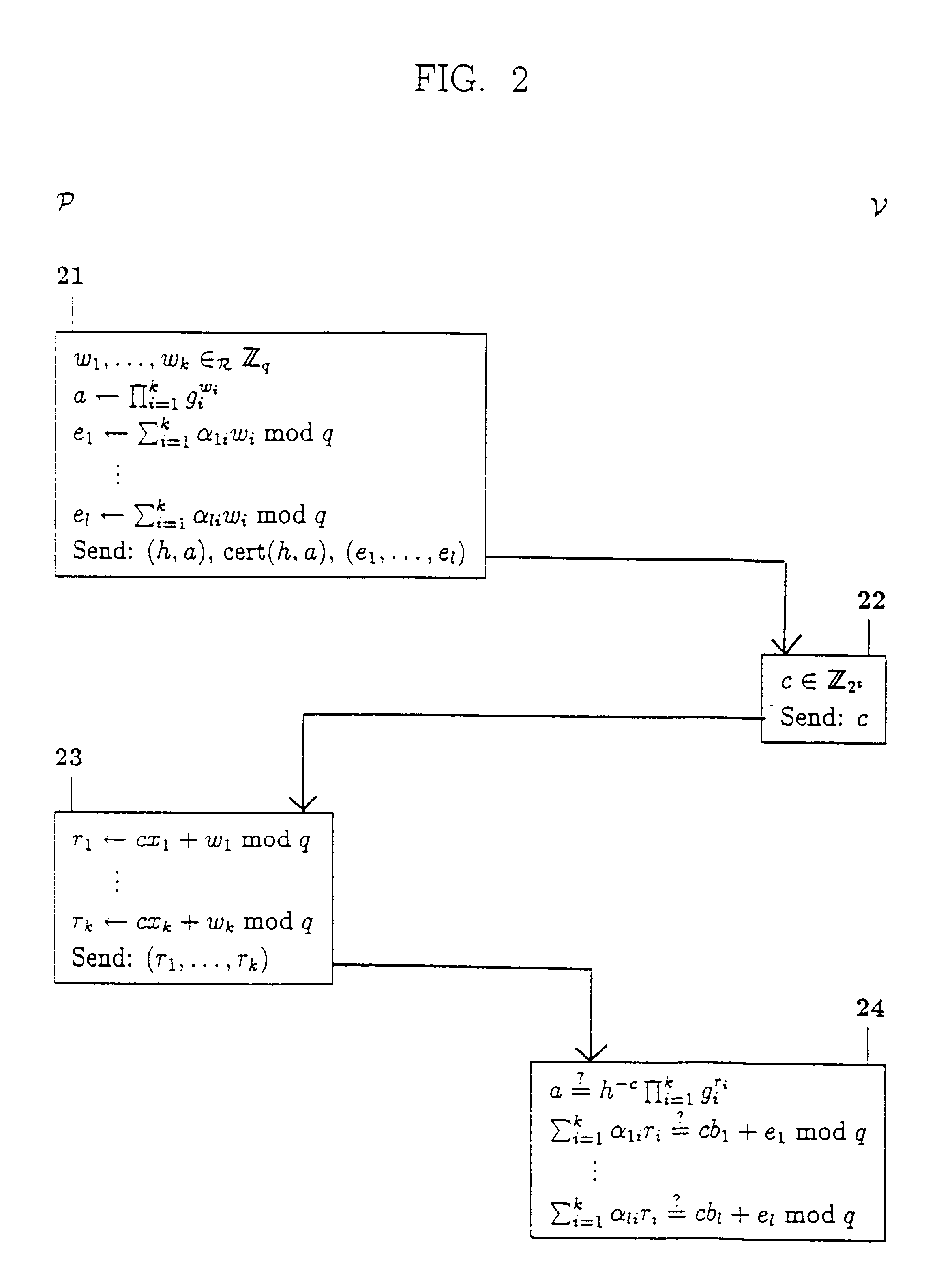Cryptographic methods for demonstrating satisfiable formulas from propositional logic
a propositional logic and formula technology, applied in the field of cryptographic methods for demonstrating arbitrary satisfiable formulas from propositional logic, can solve the problems of serious limitations in the functionality of the method for demonstrating linear relations, 980 cannot demonstrate arbitrary satisfiable formulas, and u.s. pat. no. 5,521,980 cannot be applied to demonstrate, etc., to achieve the effect of improving computational efficiency
- Summary
- Abstract
- Description
- Claims
- Application Information
AI Technical Summary
Benefits of technology
Problems solved by technology
Method used
Image
Examples
example 2
To demonstrate the formula "(x.sub.1 =2x.sub.3 +3x.sub.4 +5 mod q) AND (x.sub.2 =6x.sub.4 -7 mod q) AND (NOT (x.sub.3 =4x.sub.4 +8 mod q))," for a situation with k=5, P needs to show that x.sub.1 =2x.sub.3 +3x.sub.4 +5 mod q, x.sub.2 =6x.sub.4 -7 mod q and x.sub.3 =4x.sub.4 +8-.epsilon. mod q, for some .epsilon. that must be demonstrated to be non-zero. Substitution gives that P must prove that x.sub.1 =11x.sub.4 +21-2.epsilon. mod q, x.sub.2 =6x.sub.4 -7 mod q and x.sub.3 =4x.sub.4 +8-.epsilon.. P can perform this proof, since (.delta. mod q, x.sub.4.delta. mod q, x.sub.5.delta. mod q) is a representation of g.sub.1.sup.2 g.sub.3 with respect to (h.sup.-1 g.sub.1.sup.21 g.sub.2.sup.-7 g.sub.3.sup.8, g.sub.1.sup.11 g.sub.2.sup.6 g.sub.3.sup.4 g.sub.4, g.sub.5), where .delta.=.epsilon..sup.-1 mod q. More specifically, P computes a as h.sup.-w.sup..sub.1 g.sub.1.sup.21w.sup..sub.1 .sup.+11w.sup..sub.2 g.sub.2.sup.-7w.sup..sub.1 .sup.+6w.sup..sub.2 g.sub.3.sup.8w.sup..sub.1 .sup.30 4w....
example 3
Consider the linear relations S.sub.1 ="(x.sub.1 =2x.sub.3 +3x.sub.4 +5 mod q)," S.sub.2 ="(x.sub.2 =6x.sub.4 =7 mod q)," S.sub.3 ="(x.sub.3 =4x.sub.4 +8 mod q)," S.sub.4 ="(x.sub.1 =5x.sub.2 +7 mod q)," S.sub.5 ="(x.sub.2 =3x.sub.4 +2 mod q)," S.sub.6 ="(x.sub.1 =x.sub.2 +x.sub.4 +3 mod q)," and S.sub.7 ="(x.sub.2 =3x.sub.3 +7 mod q)," and h=.PI..sub.i=1.sup.5 g.sub.i.sup.x.sup..sub.i . Suppose that P has to demonstrate the formula F="(S.sub.1 AND S.sub.2 AND (NOT (S.sub.3 OR S.sub.7)) AND S.sub.6) OR ((NOT (S.sub.4 OR S.sub.7)) AND S.sub.5 AND S.sub.6)." By applying the rules of propositional logic, F can be re-written in the format "((S.sub.1 AND S.sub.2 AND (NOT S.sub.3)) OR ((NOT S.sub.4) AND S.sub.5)) AND (S.sub.6 AND (NOT S.sub.7))." Let now R.sub.11 ="S.sub.1 AND S.sub.2 AND (NOT S.sub.3)," R.sub.12 ="(NOT S.sub.4) AND S.sub.5," and R.sub.22 ="S.sub.6 AND (NOT S.sub.7)," and Q.sub.1 ="R.sub.11 OR R.sub.12," and Q.sub.2 =R.sub.22. P can then demonstrate the formula F to .nu. ...
example 4
Consider the linear relations of example 3, S.sub.1, . . . , S.sub.7, with h=.SIGMA..sub.i=1.sup.5 g.sub.i.sup.x.sup..sub.i . Suppose now that P has to demonstrate the formula F="(S.sub.1 AND (NOT S.sub.2) AND (NOT S.sub.3)) OR (S.sub.4 AND S.sub.5 AND (NOT S.sub.6) AND (NOT S.sub.7))." F can be re-written in the format "(R.sub.11 AND R.sub.21) OR (R.sub.12 AND R.sub.22)," where R.sub.11 ="S.sub.1 AND (NOT S.sub.2)," R.sub.21 ="NOT S.sub.3," R.sub.12 ="S.sub.4 AND (NOT S.sub.6)," and R.sub.22 ="S.sub.5 AND (NOT S.sub.7)" are all sub-formulas of F. Note that if, say, sub-formula R.sub.12 would not contain a "NOT" connective, then sub-formulas R.sub.12 and R.sub.22 could have been lumped together into one sub-formula. Now, in terms of the reference method this means that P has to demonstrate knowledge of a first and a second secret key, or a third and a fourth secret key. Hence P, after having computed four numbers a.sub.1, . . . , a.sub.4, corresponding to R.sub.11, R.sub.12, R.sub.2...
PUM
 Login to View More
Login to View More Abstract
Description
Claims
Application Information
 Login to View More
Login to View More - R&D
- Intellectual Property
- Life Sciences
- Materials
- Tech Scout
- Unparalleled Data Quality
- Higher Quality Content
- 60% Fewer Hallucinations
Browse by: Latest US Patents, China's latest patents, Technical Efficacy Thesaurus, Application Domain, Technology Topic, Popular Technical Reports.
© 2025 PatSnap. All rights reserved.Legal|Privacy policy|Modern Slavery Act Transparency Statement|Sitemap|About US| Contact US: help@patsnap.com



